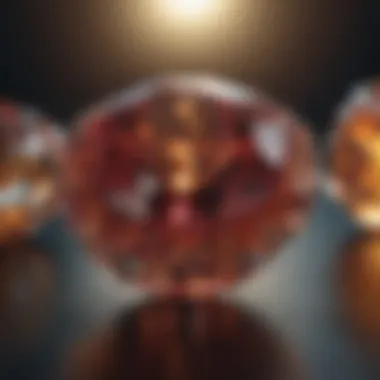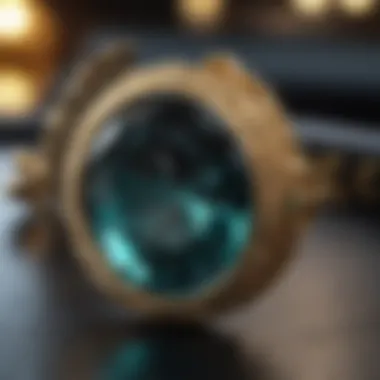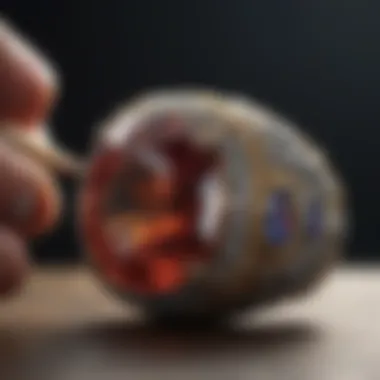Mastering the Intricacies of Crafting Exquisite Fine Jewelry: An In-Depth Guide


Overview of Gemstones a Minerals
Gemstones and minerals possess a rich history that dates back centuries, playing a significant role in cultural practices and societal customs. These exquisite natural treasures have been cherished and revered for their beauty and rarity, symbolizing status, power, and personal style. Throughout various civilizations, gemstones and minerals have held both mystical and practical importance, often being used as adornments, currency, or talismans.
Gemstone Formation and Properties
The formation process of gemstones is a fascinating journey that takes millions of years under the earth's surface. Through intense heat, pressure, and mineral interactions, natural gemstones undergo a complex transformation to attain their stunning crystalline structures. These geological processes imbue each gemstone with unique properties that define its characteristics, including color, hardness, transparency, and refractive index. Gemstones are classified based on these properties, categorizing them by their distinct color profiles, Mohs hardness scales, and reflective qualities.
Types of Gemstones
Within the realm of gemstones, we encounter a diverse array of categories that distinguish between precious and semi-precious stones. While precious gemstones like diamonds, rubies, sapphires, and emeralds command exceptional value due to their rarity and brilliance, semi-precious gemstones such as amethyst, citrine, and turquoise offer a more accessible yet equally captivating allure. Additionally, there exist exotic and rare gemstones that fascinate collectors and enthusiasts with their exceptional beauty and scarcity, drawing admiration for their unparalleled uniqueness and exquisite aesthetics.
Identifying and Evaluating Gemstones
The value of a gemstone is determined by various factors that influence its rarity, quality, and desirability in the market. Gemstone identification involves intricate techniques such as assessing color saturation, clarity, cut precision, and carat weight to distinguish genuine gemstones from imitations or synthetics. Evaluating gemstone quality requires a keen eye for detail and an understanding of industry standards to ensure the authenticity and worth of each stone, enabling buyers and sellers to make informed decisions based on accurate gemstone grading and assessment.
Caring for Gemstones
Proper care and maintenance are essential to preserve the beauty and longevity of gemstones, safeguarding them against damage and deterioration over time. Cleaning gemstones regularly with mild soap and water, storing them away from harsh chemicals and direct sunlight, and avoiding common mistakes like exposing them to extreme temperatures or abrasive surfaces are crucial steps in ensuring their lasting shine and luster. Specific gem types may require tailored preservation techniques to retain their color vibrancy and brilliance, making it imperative to follow expert guidance on caring for each gemstone variety with personalized attention and diligence.
Introduction
As we begin our journey into the realm of fine jewelry craftsmanship, it is imperative to grasp the intricate artistry that underpins this elegant craft. Fine jewelry stands as a testament to human creativity and mastery, reflecting a harmonious blend of skill, passion, and precision. Within the context of this comprehensive guide, we will unravel the nuanced layers of creating exquisite jewelry pieces, exploring the profound beauty that emanates from the fusion of gemstones and precious metals.
Exploring the World of Fine Jewelry
Understanding the allure of fine jewelry
Delving into the essence of fine jewelry unveils a world where sophistication meets artistry in a tangible form. The allure of fine jewelry lies in its ability to transcend mere adornment, offering a narrative of legacy, heritage, and individuality. Crafted with meticulous attention to detail, each piece exudes a unique charm that captures the essence of its creator's vision. The significance of fine jewelry extends beyond aesthetics, becoming a symbolic representation of personal style and distinction amidst an ocean of mass-produced accessories.
Significance of craftsmanship in jewelry making
The cornerstone of fine jewelry creation rests upon the foundations of craftsmanship, heralding the marriage of tradition and modernity. The significance of masterful craftsmanship lies in its role as the guiding force behind the transformation of raw materials into exquisite works of wearable art. Every cut, every setting, and every polish is a testament to the dedication and expertise of the craftsman. Through skilled hands and unwavering commitment, jewelry makers breathe life into inert gemstones and metals, infusing them with a timeless allure that transcends fleeting trends.


Overview of Gemstones and Metals
Types of gemstones used in fine jewelry
Gemstones serve as the vibrant soul of fine jewelry, each possessing its unique hue, brilliance, and mystique. From the fiery depths of rubies to the icy coolness of diamonds, gemstones offer an endless palette of colors and meanings for artisans to explore. The choice of gemstone is a deeply personal one, reflecting not only aesthetic preferences but also symbolic significance. Whether it's the regal opulence of sapphires or the tender allure of pearls, each gemstone adds a layer of narrative depth to the jewelry creation process.
Properties of popular gemstones
Unlocking the secrets held within popular gemstones unveils a rich tapestry of geological wonders. The properties of gemstones go beyond mere physical attributes, encompassing spiritual, emotional, and even mythical connotations. Understanding the metaphysical properties of gemstones allows artisans to infuse their creations with intention and meaning, establishing a profound connection between the piece and its wearer. Whether it be the calming embrace of amethyst or the fiery passion of topaz, each gemstone offers a world of inspiration waiting to be transmuted into artistic expression.
Common metals for crafting jewelry
In the realm of jewelry crafting, metals stand as the silent backbone that lends structure, durability, and elegance to every piece. Common metals such as gold, silver, and platinum form the canvas upon which gemstones dance, their purity and malleability dictating the design's complexity and longevity. Each metal brings its unique characteristics to the table, from gold's timeless radiance to silver's cool sophistication. The selection of the metal is a pivotal decision in jewelry making, shaping not only the visual aesthetics but also the tactile experience of the final piece.
Gemstone Selection and Evaluation
In the intricate realm of fine jewelry craftsmanship, the selection and evaluation of gemstones hold paramount significance. Gemstones are the soul of any jewelry piece, defining its beauty, rarity, and value. The process of meticulously choosing the right gemstone involves a nuanced understanding of various factors like color, clarity, cut, and carat weight. Each gemstone possesses unique properties that contribute to its allure and desirability. Ensuring the gemstone aligns with the design concept and quality standards is crucial in creating exquisite jewelry pieces that resonate with connoisseurs and enthusiasts alike.
Choosing the Right Gemstone
Factors to consider when selecting a gemstone
When embarking on the journey of selecting a gemstone for fine jewelry, several crucial factors come into play. The color of the gemstone holds immense importance as it sets the tone for the entire piece, evoking emotions and enhancing aesthetics. Clarity determines the gemstone's purity, with fewer inclusions signifying higher quality. The cut of the gemstone impacts its brilliance and sparkle, revealing its true beauty. Carat weight influences the gemstone's size and, consequently, its perceived value. Considering these factors meticulously ensures the chosen gemstone harmonizes with the jewelry design, elevating its visual appeal and value.
Assessing gemstone quality also involves evaluating aspects such as origin, treatments, and fluorescence. Understanding the gemstone's origin provides insight into its rarity and ethically sourced nature. Awareness of any treatments applied to enhance color or clarity is essential in determining the gemstone's durability and longevity. Fluorescence affects how the gemstone appears under different lighting conditions, influencing its overall charm. By assessing these quality parameters, artisans can select gemstones that meet the highest standards of excellence, resulting in captivating and enduring jewelry creations.
Gemstone Identification Techniques
In the realm of gemstone selection and evaluation, the mastery of gemstone identification techniques is indispensable. Authenticating gemstones ensures that they are genuine, natural, and of the highest quality, instilling trust and confidence in discerning consumers. Methods for identifying gemstone authenticity involve visual inspection, magnification, and testing through specialized instruments. These techniques help in distinguishing natural gemstones from synthetics or imitations, safeguarding the integrity and value of the jewelry piece.
Tools play a crucial role in the thorough evaluation of gemstones, aiding artisans in assessing essential characteristics like color consistency, transparency, and structural integrity. Advanced equipment like refractometers, spectrometers, and microscopes enable precise measurements and in-depth analysis, guiding artisans in making informed decisions during the gemstone selection process. By leveraging these tools effectively, artisans can guarantee the authenticity and superior quality of the gemstones used in their creations, reinforcing the allure and craftsmanship excellence of fine jewelry.
Jewelry Making Process
Crafting fine jewelry is a meticulous and intricate process that requires a delicate balance of creativity, precision, and technical skill. In the realm of jewelry making, each step contributes to the creation of a masterpiece that embodies elegance and sophistication. From conceptualization to the final product, every stage plays a crucial role in bringing a designer's vision to life.


Within the jewelry making process, one of the primary aspects is the art of designing fine jewelry. Designing serves as the cornerstone of the entire craft, where creativity meets technique to produce stunning pieces that resonate with beauty and uniqueness.
Designing Fine Jewelry
Creating jewelry sketches and blueprints
When it comes to creating jewelry sketches and blueprints, attention to detail is paramount. Sketches serve as the visual representation of a designer's imagination, translating ideas into tangible forms. These initial drawings capture the essence of a piece, outlining its shape, structure, and overall aesthetic. By meticulously planning every curve and contour, designers lay the foundation for exquisite creations.
The process of sketching allows artists to explore various possibilities, experimenting with different layouts and compositions to refine their concepts. Through this iterative approach, designers can bring forth the best version of their vision, ensuring that every element harmonizes seamlessly.
Incorporating gemstones into designs
Gemstones hold a special place in the world of fine jewelry, adding allure and vibrancy to each piece. When incorporating gemstones into designs, designers must carefully consider factors such as color, cut, and clarity to enhance the overall allure of the jewelry. By strategically placing gemstones within a design, artists can create focal points that captivate the eye and elevate the aesthetic appeal of the piece.
The art of integrating gemstones requires a delicate balance between craftsmanship and creativity. Designers must envision how each gemstone will interact with the metalwork, ensuring that the final composition exudes elegance and sophistication. By skillfully blending gemstones into their designs, artists infuse each piece with a touch of luxury and exclusivity.
Mastering Jewelry Crafting Techniques
Soldering and metalworking
Soldering and metalworking are foundational techniques in jewelry crafting, essential for creating durable and intricate pieces. Soldering involves joining metal components using a filler material, ensuring that the connections are secure and seamless. This technique demands precision and expertise, as any flaws in the soldering process can compromise the structural integrity of the jewelry.
Metalworking complements soldering, allowing artists to shape and mold metal into various forms. From forming intricate patterns to sculpting unique textures, metalworking enables designers to infuse personality and character into their creations. By mastering the art of soldering and metalworking, artisans lay the groundwork for exceptional craftsmanship and innovation.
Setting gemstones in jewelry
The process of setting gemstones in jewelry requires meticulous attention to detail and a steady hand. Whether it's a dazzling diamond or a vibrant sapphire, securing gemstones in place is essential for both aesthetic appeal and durability. Different setting techniques, such as prong, bezel, and pave, offer unique ways to showcase gemstones while ensuring their safety and stability.
Each setting technique lends a distinct character to the jewelry piece, influencing its overall design and visual impact. Designers must carefully select the appropriate setting based on the gemstone's properties and the intended aesthetic outcome. By expertly setting gemstones in jewelry, artisans transform raw materials into breathtaking works of art that transcend time and trends.
Finishing Touches and Quality Control
The section on Finishing Touches and Quality Control delves deeply into the critical aspects of jewelry making that ensure the final product is of the highest quality. Attention to detail in this phase is paramount in creating exquisite jewelry pieces that dazzle and endure. Achieving a flawless finish and maintaining rigorous quality control standards elevate a piece from good to exceptional.
Polishing and Refining Jewelry


Methods for achieving a high polish
The process of achieving a high polish is a meticulous art form where skilled craftsmen use a combination of traditional techniques and modern technology to create a mirror-like finish on jewelry surface. The key to a high polish lies in the meticulous grinding and buffing of the metal, resulting in a lustrous shine that enhances the beauty. This impeccable polish not only enhances the aesthetic appeal of the jewelry but also adds to its perceived value and desirability. The uniqueness of this method lies in its ability to transform a dull piece into a radiant masterpiece, showcasing craftsmanship at its finest.
Adding texture and finishes to jewelry
In the realm of jewelry making, adding texture and finishes plays a vital role in enhancing the visual interest and uniqueness of a piece. The process involves creating different surface finishes like matte, brushed, hammered, or satin, adding depth and character to the jewelry. Each finish contributes to the overall aesthetic, giving jewelry a distinct personality and style. While textures create a tactile experience for the wearer, finishes often serve as a defining element that sets a piece apart. The advantage of incorporating varied textures and finishes lies in the ability to cater to diverse tastes and fashion trends, ensuring the jewelry remains relevant and appealing in different contexts.
Quality Assurance in Jewelry Making
Inspecting jewelry for flaws
The meticulous inspection process for flaws is a critical step in ensuring the final piece meets the highest standards of quality. By scrutinizing every detail from gemstone settings to metal finishes, craftsmen can identify even the slightest imperfections that may compromise the integrity of the jewelry. This attention to detail not only ensures a flawless end product but also reflects the dedication to craftsmanship and excellence. Examining jewelry for flaws guarantees that each piece that leaves the workshop is a testament to superior quality and precision.
Ensuring durability and longevity
Ensuring the durability and longevity of jewelry is paramount in maintaining its intrinsic value and preserving its beauty over time. By selecting robust materials, applying industry-standard techniques, and conducting thorough durability tests, craftsmen can create jewelry pieces that withstand the test of time. The key characteristic of this practice is the commitment to using high-quality materials and employing proven techniques that enhance the longevity of the jewelry. This emphasis on durability not only adds to the desirability of the piece but also ensures that it can be cherished for generations to come.
Marketing and Showcasing Your Jewelry
Marketing and showcasing your jewelry are integral aspects of the article focused on mastering the art of crafting fine jewelry. In today's competitive market, establishing a robust marketing strategy and effectively showcasing your creations are essential for success. Marketing involves creating awareness and interest in your brand and products, while showcasing ensures that your jewelry collection receives the attention it deserves. Both components play a significant role in building a reputable brand and attracting customers.
Building Your Brand Identity
Crafting a unique brand story
Crafting a unique brand story is a critical element in establishing a strong brand identity within the jewelry industry. A compelling brand story sets you apart from competitors by highlighting the inspiration, craftsmanship, and values behind your creations. The key characteristic of crafting a unique brand story lies in its ability to emotionally engage with customers, creating a personal connection that goes beyond the product itself. This humanizes your brand and resonates with consumers looking for authenticity and meaning in their purchases, making it a popular choice for this article. The unique feature of crafting a unique brand story is its potential to foster brand loyalty and long-term customer relationships, making it a valuable asset in building a sustainable jewelry business.
Establishing an online presence
Establishing an online presence is a vital component of modern marketing strategies for jewelry designers. In today's digital age, having a strong online presence increases brand visibility, accessibility, and reach to a global audience. The key characteristic of establishing an online presence is the ability to showcase your jewelry collections 24/7, allowing potential customers to browse and purchase at their convenience. This accessibility makes it a popular choice for reaching a wider customer base and expanding market reach. However, the unique feature of online presence also comes with challenges such as maintaining security and authenticity in an increasingly competitive online market, necessitating a robust digital marketing strategy to stand out.
Showcasing Your Jewelry Collection
Organizing jewelry exhibitions
Organizing jewelry exhibitions serves as a traditional yet effective method of showcasing your jewelry collection to a targeted audience. The key characteristic of organizing jewelry exhibitions is the immersive experience it provides, allowing customers to interact with your creations in a tangible and memorable way. This personalized engagement fosters a deeper connection between the consumer and your brand, leading to increased sales and brand loyalty. While organizing exhibitions offers advantages in establishing a strong brand presence and networking with industry professionals, it also requires significant logistical planning and financial investment.
Utilizing social media for promotion
Utilizing social media for promotion is a contemporary approach to showcasing your jewelry collection to a vast online community. The key characteristic of social media promotion is its ability to leverage visual content to engage with followers, generate interest, and drive traffic to your online platforms. This real-time interaction with potential customers fosters brand awareness and helps in building a loyal online following. However, the unique feature of social media promotion lies in its ever-evolving nature, requiring consistency, creativity, and adaptability to maintain relevance and effectiveness in promoting your jewelry brand.







